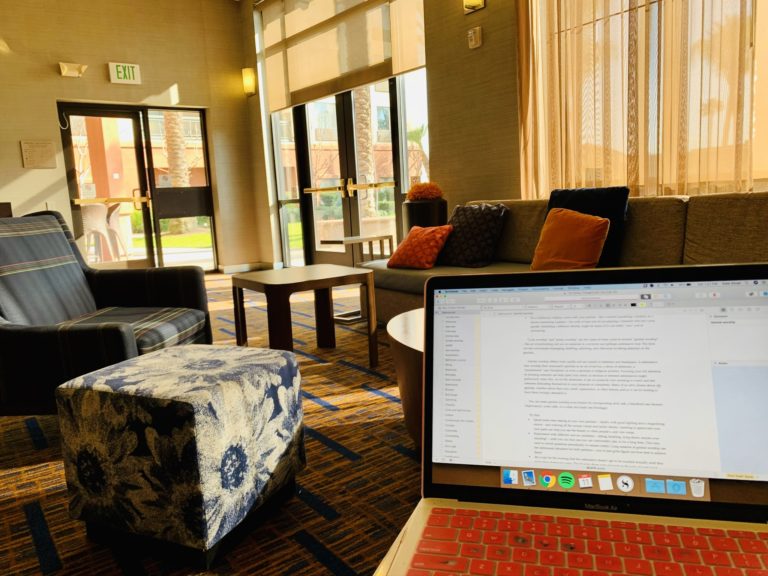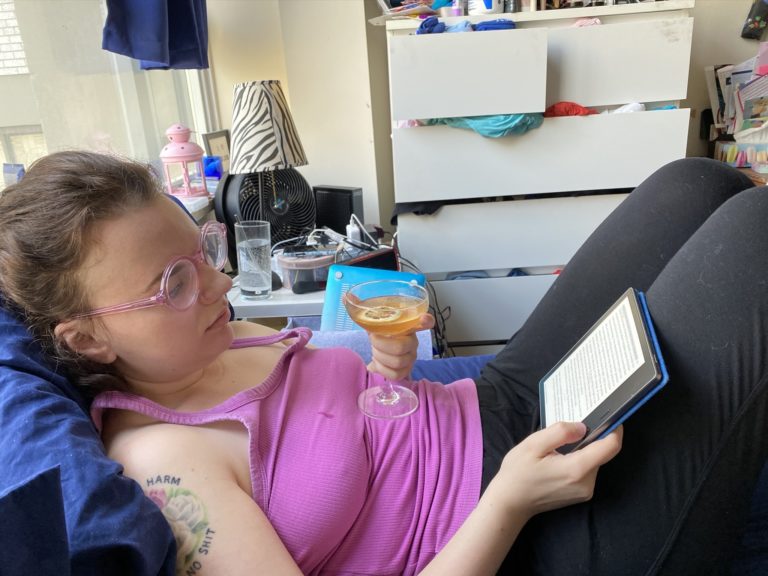
Today I read an article about Stephin Merritt, the lead singer and songwriter of the Magnetic Fields – arguably one of the best songwriters of my generation – which had this to say about his creative process:
[Stephen is] a crazily prolific songwriter… The problem is that he can only write songs in bars. And not just any bar – it needs to be “one-third full of cranky old gay men gossiping over thumping disco music.” Plus he needs a glass of cognac, to be slowly sipped, and a corner with a light so he can see his notebook.
I was immediately captivated by this description. I knew Stephin liked to write in loud bars, but I didn’t know he only liked to write in loud bars – or that cognac factored into the equation.
What artists of various sorts like to do to stoke their creativity has long been a source of fascination to me. My own process is ever-evolving, in part based on what I read about other writers’ and creators’ processes. So today I thought I’d create a little survey, which you are free to duplicate on your own site if you’d like to answer these questions yourself. Here are my answers…
What’s your workspace like? I have an antique wooden desk that was rescued from the side of the road many years ago and has come with me to 3 different homes. It’s big enough for my computer, microphone, and headphones, plus all the various medications I take, a notebook and pen/pencil, and a black Museum of Sex mug containing all my writing implements.
Beverage of choice while working? During the day: a latte (I like a lot of different kinds, but a soy toffee nut latte from Starbucks is a common one lately) or a cup of tea. At night, when I occasionally also write: a dirty martini to help keep the words flowing without self-consciousness. I also try to continually drink water throughout the day, though I’m not always great at remembering to do this.
Favorite snack while working? Sometimes I do this thing where I order coffee and breakfast from Starbucks in the morning and throw in a slice of lemon loaf for later, which inevitably I suddenly remember exists around 3 p.m. and get extremely excited to eat. Aside from that – I’m a very snacky person but not organized/methodical enough to habitually keep snacks in stock, so these days I don’t snack much throughout the day even though I want to. If I ordered Mexican food last night and still have tortilla chips and guacamole left over, that’s my favorite mid-day snack.
Music of choice while working? Something instrumental and either peppy or dramatic. Most often I just hit shuffle on my “I’m a Writer” playlist. If there’s a particular mood I’m trying to embody in what I’m working on (e.g. fun, melancholy, energetic), I’ll put on music that makes me feel that way.
Favorite tools? My MacBook Air for nearly everything, and my iPad mini on bad pain/fatigue days. I journal in lined Moleskine notebooks with a Retro 51 Tornado pen. There’s also often a pink Poppin task pad and matching pink Palomino pencil next to me at my desk, for scribbled notes and to-do lists.
Favorite software? The plain ol’ Notes app for on-the-go note-taking and drafting. Scrivener for book-length projects. Evernote for some projects that require a lot of research, sources, and interviews. Google Docs/Drive as a backup compendium and for the vast majority of my non-blog writing (I love that it autosaves constantly).
Favorite places to work in your home? There are 3 options in my tiny apartment: bed, couch, and desk. Most often I pick bed, which I’m not proud of but is sometimes necessary as a result of chronic illness/pain. My building also has a rooftop patio where I did some book edits once and should probably write more often. Once in a while I stay over at my parents’, where I have a small desk (also rescued from the roadside, incidentally!) as well as their kitchen table or back yard to choose from.
Favorite places to work outside the home? I’m mostly relegated to my home right now ’cause coronavirus, but in normal times, I love writing at cafés (usually on my laptop) and bars (usually in a notebook) – men try to hit on me occasionally and there are a lot of distractions, but the overall boost in creativity, energy, and motivation is worth it for me. Sometimes, if I’m writing a piece that takes place at a particular location that’s accessible to me, I’ll go there to write so I can capture the details better. Also, oddly I get a lot of writing done in airports – maybe because I’m stuck there for a while and bored enough to want to work.
What times of day yield your best work? Honestly, any times when I’m not wracked by chronic illness symptoms. For me, that’s usually late afternoon, early evening, or very late at night. (Before I met my partner, anyway. Since meeting them, I’m typically on the phone with them til at least midnight so I haven’t had nearly as many of the obsessive wee-hours writing marathons as I often would in my youth.) I try to follow my natural impulses in this area and take advantage of any sudden “I feel like writing!!” whims, even if they happen at odd times.
Favorite work clothes? Anything comfy. Usually loungewear from MeUndies or the Gap. As I write this, I’m wearing my full-body black modal hooded onesie from MeUndies and it is truly ideal. Occasionally I put on a “real” outfit and some makeup, to make me feel more put-together and focused, but many days I can’t quite manage that and it usually works out okay anyway.
Start-of-workday rituals? Not as defined as I would prefer, mostly because I am very much not a morning person and I have to get up at 9 a.m. every weekday to do some morning tasks for my part-time social media job. Usually I just take my antidepressant, put on some music, and get started.
End-of-workday rituals? Close my laptop and physically walk away from it so I don’t feel tempted to just keep answering emails and drafting blog posts all evening. Wash all the dirty dishes in the sink – which may not seem creativity-related but is actually one of those boring, methodical tasks that can be oddly fertile soil for random creative thoughts. Make a cocktail and eat dinner while watching videos on YouTube or catching up on the articles in my RSS reader.
How do you handle distractions while you’re working? Not very well. When I’m doing a good job at this, usually I put my phone and computer on “do not disturb” (making sure to notify my partner and best friend if I plan on doing this for a long time, so they don’t worry about me) before I dive into a writing sesh. I also use a site blocker to keep myself off Twitter, and close my email app before starting a piece of writing.
Do you take breaks? What are they like? I used to be able to work for hours on end, but now that I’m plagued with daily pain and fatigue, I take a lot more breaks than I used to. Sometimes that just means a 20-minute lie-down between tasks to play a game on my phone or read a random weird Wikipedia article; other times it’s a full-on 3-hour nap, complete with eye mask, drawn shades, and soothing music. I’m trying to get better at listening to my body and doing what it asks of me.
How do you track your progress? My daily to-do list is kept in my Notes app, which my partner can access and keep an eye on (they’ll often send me a sweet congratulatory text when I get everything done). Other than that, I like looking at the full-month view in my Editorial Calendar plugin for WordPress; it gives me a sense of which blog slots have already been filled and which I still need to write content for. I don’t focus as much on word count as some other writers do, because most of the writing I do day-to-day is inherently unrestrictive in terms of word count. I guess looking at my income spreadsheet is also a way of tracking my progress!
How do you celebrate or cap off a completed project? My partner reads aloud to me, on our nighttime phone calls, any articles or blog posts that I wrote throughout the day. Hearing them out loud, and getting mb’s feedback, helps me figure out what I might need to change before publication.
Do you have any superstitions about your work? Not exactly, but on deadline days I have been known to adorn myself with a whole lot of blue topaz jewelry because blue topaz is known as the writers’ crystal and is said to amplify your communicative powers. The effect may be placebo-based but there is an effect nonetheless, so I say, why the hell not?
What do you do when you’re creatively blocked? Go for a walk. Read writers I admire. Read generally. Write something in a different medium than my usual (e.g. fanfiction). Listen to podcasts. Take a day off, if possible, to just rest and do absolutely nothing (I get bored and remember why I enjoy writing). Look at the terms people are searching for on my site, or typing into Google before they stumble on my blog, to get a sense for what questions people need answered and what subjects stress them out. Talk to a friend on the phone.
Is there anything about your creative process that other people might think is “weird”? Possibly the weirdest thing is that I play Scrabble on my phone whenever I need to clear my brain and/or calm down. I felt validated in doing this when I learned that Angie Kim likes to play Jacks at the start of every writing session and whenever she’s stuck. There is something about playing a game – especially a game you’re good enough at that you don’t have to consciously think about your technique all that much – that can feel very calibrating and calming.
What aspects of your creative process do you hope to improve upon? After all these years of doing what I do, I feel like I’ve mostly got my own patterns and rhythms figured out, so I know how to optimize for them – but chronic illness has really thrown a wrench into that. Now I’m working on re-learning what works best for me in my new body and brain. I know I can; it’ll just take time!
What are some aspects of other people’s creative processes that you find inspiring or admirable? I mentioned Stephin Merritt early in this post and I still find his process fascinating. How do you write well – let alone write songs well – in a loud bar?! Every time I read about someone whose process is radically different from mine, it makes me want to try their method just to see how it would affect me. I also admire Esmé Wang‘s commitment to beginning each day by pulling tarot cards and journaling.
If you feel like filling out this survey on your own blog, or even just on Medium.com or somesuch, feel free to post a link in the comments!




